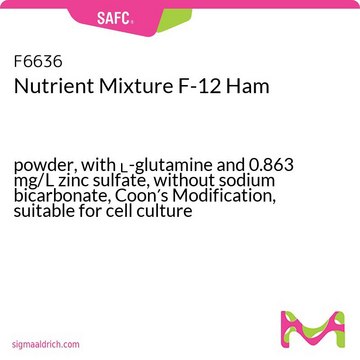Kluczowe dokumenty
51651C
Ham′s Nutrient Mixture F12
liquid
Synonim(y):
Nutrient Mixture F12 Ham’s
About This Item
Polecane produkty
opis
for research or for further manufacturing use
with 1.0 mM L-glutamine
sterylność
sterile
Formularz
liquid
jakość
for further manufacturing use
metody
cell culture | mammalian: suitable
komponenty
NaHCO3: 1176 mg/L
sodium pyruvate: 110.1 mg/L
phenol red: 1.274 mg/L
L-glutamine: 146.2 mg/L
Warunki transportu
ambient
temp. przechowywania
2-8°C
Szukasz podobnych produktów? Odwiedź Przewodnik dotyczący porównywania produktów
Zastosowanie
suplement
Kod klasy składowania
12 - Non Combustible Liquids
Klasa zagrożenia wodnego (WGK)
WGK 1
Temperatura zapłonu (°F)
Not applicable
Temperatura zapłonu (°C)
Not applicable
Wybierz jedną z najnowszych wersji:
Masz już ten produkt?
Dokumenty związane z niedawno zakupionymi produktami zostały zamieszczone w Bibliotece dokumentów.
Klienci oglądali również te produkty
Nasz zespół naukowców ma doświadczenie we wszystkich obszarach badań, w tym w naukach przyrodniczych, materiałoznawstwie, syntezie chemicznej, chromatografii, analityce i wielu innych dziedzinach.
Skontaktuj się z zespołem ds. pomocy technicznej





